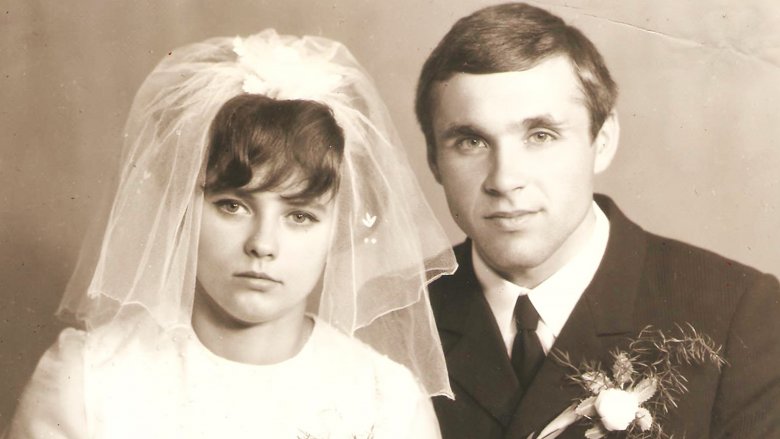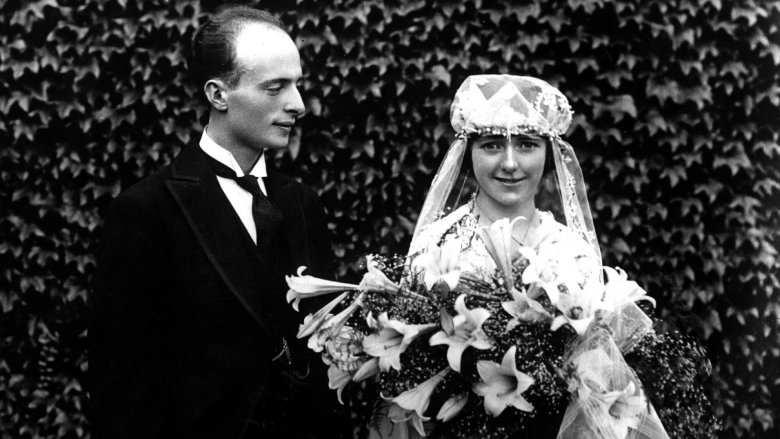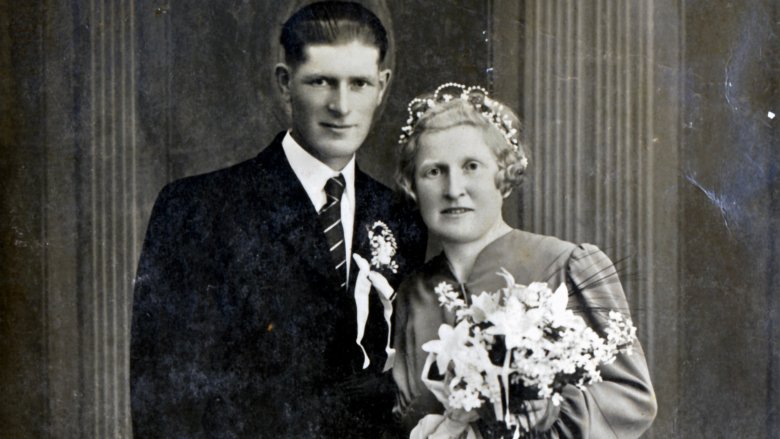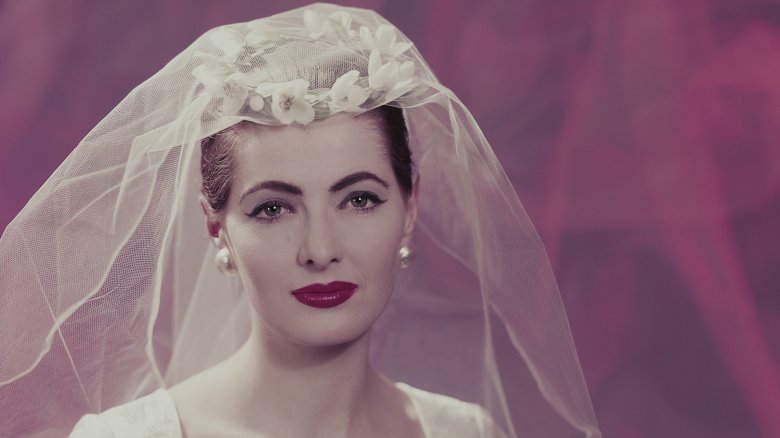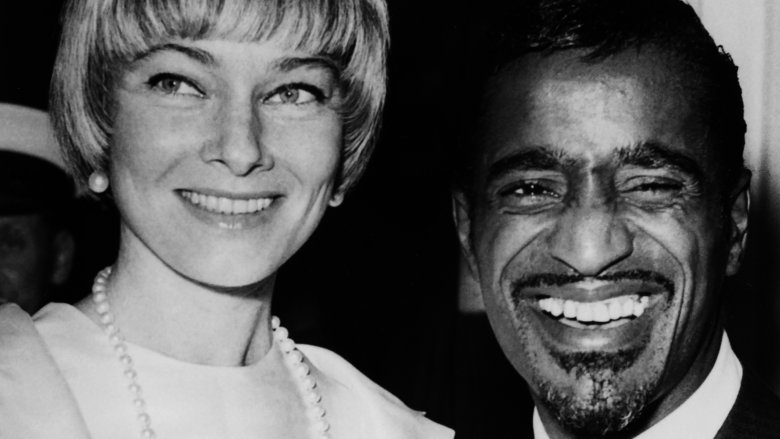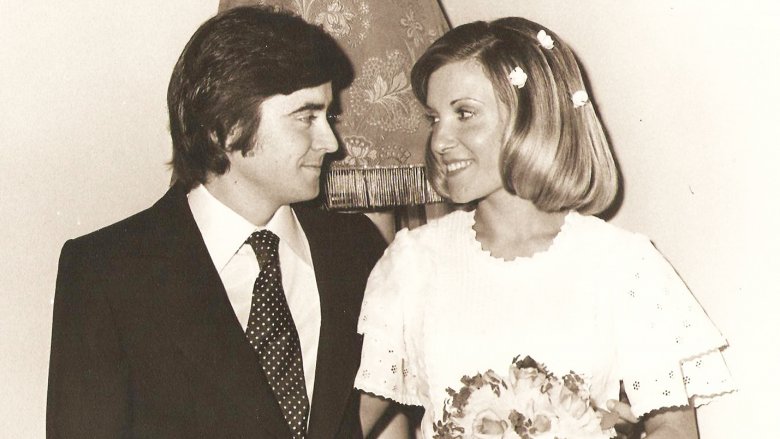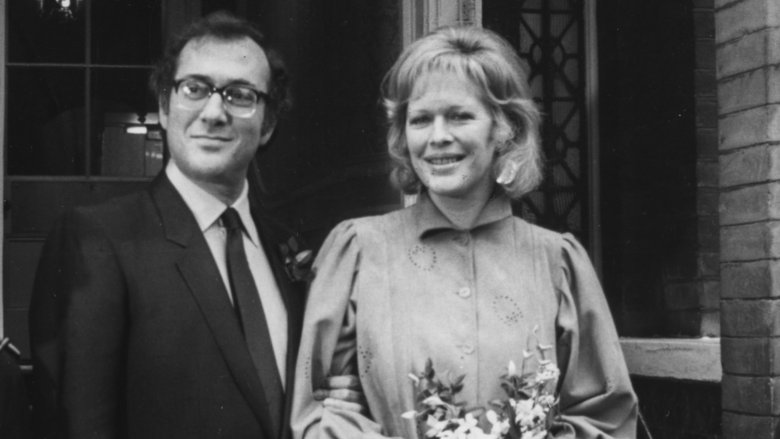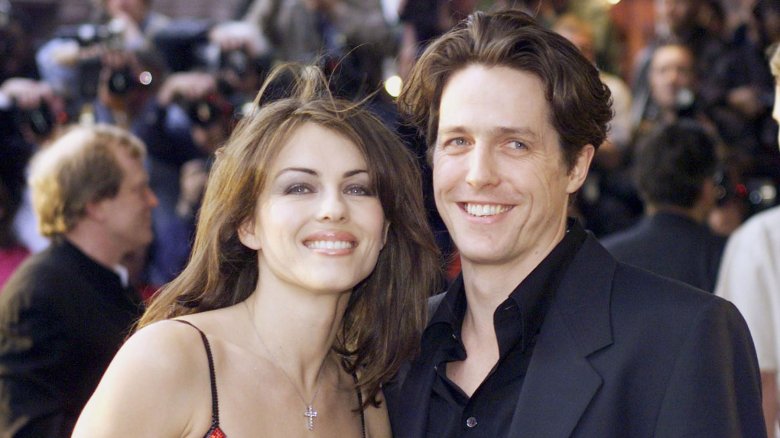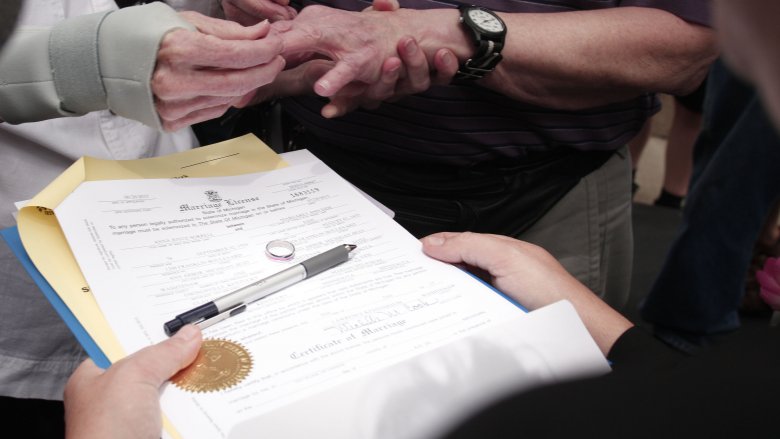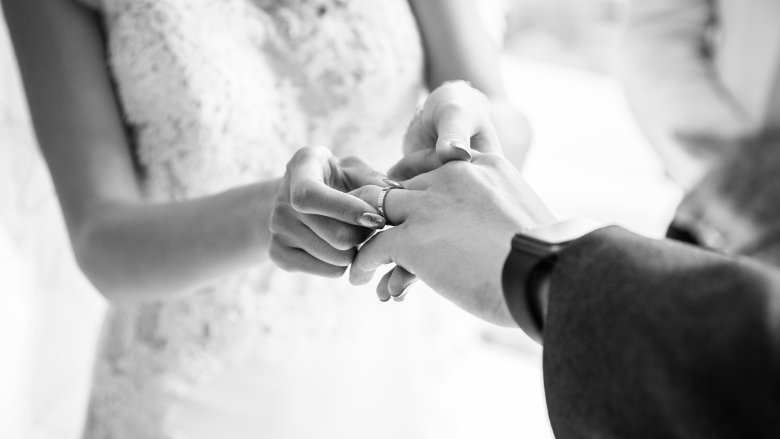How Marriages Have Changed Over The Last 100 Years
For better and for worse, the world has vastly changed over the past century. By 1918, the most popular vehicle was Henry Ford's Model T and Charlie Chaplin was reigning supreme on screen. As World War I came to be, many men needed to vacate their jobs to serve in the war effort. Although women were still without voting rights, they took to the workforce en masse to fill the open positions. Other women also volunteered for active duty — a first in American history — and tens of thousands would go on to serve as Army and Navy nurses.
Relationships were also much different in those times. It wasn't until the turn of the twentieth century that dating — as opposed to courtship — became customary. Some 50 years later, "free love" — or sex without commitment — would also come into the picture. With the century-long evolvement of romantic relationships, it's not surprising that marriages would also be susceptible to change. What is surprising, however, is just how dramatically different these unions would become. Here's how — and what — marriages changed in the past 100 years.
The reason for marrying began to shift
While loveless marriages still exist today, you wouldn't call them the norm. Right up until the end of the 18th century, though, love and marriage were mutually exclusive. "Marriage was far too important as a political and economic institution — it was the way the upper class signed peace treaties and made war," Stephanie Coontz, a professor of history and family studies at Evergreen State College and director of research and public education for the Council on Contemporary Families, told Public Radio International (PRI). For middle-class folks, marriage was essentially a way to make a business arrangement and, for the lower class, "it was the way you got your working partner."
It took a while for people to fully grasp the idea of love and marriage being two members of the same team. By the early 1900s, another mentality also worked its way into the equation. "We added to this the idea that marriage should be based on sexual attraction and fulfillment," Coontz explained. Essentially, this is how the "opposites attract" philosophy got its start.
The marriage rate and the Great Depression
Just because love and attraction became more and more important as the twentieth century progressed, waiting "too long" to marry was not exactly acceptable — and this was the case for both men and women. "There was a lot of social pressure from elites who could penalize people — as late as the 1950s and '60s, a man who wasn't married or who was divorced was often passed over for a promotion," Coontz told PRI. And what about women? Well, as the professor explained, "a woman was just basically no where." Sigh.
Although there was a ton of societal pressure to marry placed on the shoulders of men and women, the Great Depression had other ideas. According to History, high unemployment rates prevented couples from being able to afford to start families of their own. Likewise, the marriage rate in the United States fell a staggering 22 percent between the years of 1929 to 1933.
The golden age of marriage wasn't really so golden
Hope for marriage may have seemed lost by the '30s, but World War II — and the subsequent "industrial boom"— brought with it a surge of matrimony. By the 1950s, the United States was entering its so-called "golden age of marriage." But, as the old Shakespearean adage goes, all that glitters is not gold. This would be especially true of the '50s marriage model.
"People look back to that as the traditional family, but it was probably the only time in history when a vast majority of women did not work," Coontz told PRI. Men who farmed for a living were not accompanied by their wives nor were the men who ran small businesses. Thus, the "male breadwinner" dynamic took root, but, according to Coontz, that is "not the least bit traditional, and it was organized around these very rigid gender roles."
Marriage would be complicated further because of quick six-month courtships, making it difficult for couples to truly get to know one another. That's not to say all midcentury marriages were doomed, but, as Coontz said, "Basically you married a gender stereotype and you didn't have a lot to negotiate."
The case for Loving
In an incredibly bleak time in American history, intermarriage, or interracial marriage, was considered illegal in certain states. A change was set in motion when Richard and Mildred Loving, an interracial couple who'd married in Washington, D.C. in 1958 were arrested upon returning to Virginia. After pleading guilty, the state ordered the husband and wife to leave the state. On the Lovings' behalf, the American Civil Liberties Union (ACLU) began the appeal process and, some years later in 1967, the Supreme Court ruled that marriage "across racial lines" was legal in all states.
That same year, intermarriage made up around three percent of all marriages and has continued to increase since, according to the Pew Research Center. By 2015, one in six newlyweds were married to a person of a different race or ethnicity. That same year, there was also a 15 percent increase from 2010 in the number of people who think a "growing number of people marrying someone of a different race is good for society."
The start of voluntarily childless marriages
"Voluntary childlessness is becoming an increasingly prevalent alternative lifestyle in contemporary American society," wrote a Family Relations journal article (via JSTOR). While you could think that was written today, that was actually published some three decades ago.
While the rate of childlessness in ever-married women between the ages of 20 and 24 was around 25 percent back in the "baby boom" of 1960, it jumped to a whopping 44 percent by 1975. By 1979, it was estimated that ten percent of women who are, or were ever, married would continue to be childless and about five percent would do so voluntarily. Five percent may not seem like a huge number, but with the baby boom not far behind them, that's a big deal.
Voluntarily childless marriages were, of course, made easier to achieve with the legalization of the birth control pill. Though the contraceptive earned FDA approval in 1960, it wasn't legalized throughout the country until 1965. At that time, it was solely for married couples.
The waiting game
Between 1920 and 1940, the average age of women and men when they first married didn't fluctuate too much. Grooms were saying "I do" at an average of 24 years old, while brides were approximately 21. The 1950s saw even younger couples getting married. Women, on average, were walking down the aisle at just 20 years old and men were between the ages of 22 and 23. If you can't remember a time when people married so young, this is because all of this changed when the 1980s came around.
For the first time in over 90 years, women were getting married at the average age of 22. This number would continue to creep upward throughout each decade that spanned further and further into the twentieth century. And, by 2010, women had decided to wait until the average age of 26 to get married. Men averaged two years older at 28. These days, a 20-year-old bride or a 22-year-old groom would be quite the rarity.
The rise in cohabitation versus marriage
Divorce rates have decreased since the 1980s, yet nearly 50 percent of all marriages still end in divorce. The boom of divorces pre-1980, as well as the less-than-favorable current odds, have scared some people away from the idea of marriage. Robert Emery, a psychology professor at the University of Virginia told the school's publication, "It makes young people today less secure in the idea of committing to and being in a lasting marriage. Much of the rise in cohabitation as an alternative to marriage is actually an alternative to divorce." He added, saying, "If you never make a commitment, you are never going to divorce."
The professor wasn't kidding when he mentioned the "rise in cohabitation." According to the National Marriage Project, the number of unmarried couples in the U.S. was nearly five million in the year 2000. In 1960, that number was a paltry 500,000. It's estimated that about a quarter of women between the ages of 25 and 39 are now living with their partner and half have lived with a partner at some point. That's a whole lot of cohabiting.
The inclusion of same-sex couples
Although the first documented gay rights organization dates back to 1924, some 90 years would pass before same-sex marriage was legally recognized. In June 2015 — aka the twenty-first century — the United States became the twenty-first country to recognize same-sex marriages. This came to fruition after the Supreme Court ruled that same-sex couples would be free to marry in all 50 states and thus were entitled to the same legal rights and benefits afforded to heterosexual couples.
With the newfound freedom to marry, many same-sex couples did just that. In August 2017, just two years and two months after the Supreme Court ruling, over ten percent of of lesbian, gay, bisexual or transgender (LGBT) adults in the United States were reported to be married to a same-sex spouse, according to Gallup. Prior to the Supreme Court's decision, that number was a little under eight percent. Gallup also estimates that, as of 2017, 61 percent of same-sex, cohabiting couples residing in the U.S. have since married, which is a 38 percent increase pre-ruling.
The marriage rate is back on the decline
Even with more same-sex marriages occurring since 2015, the overall marriage rate is declining at a rapid pace, and has since 1970. The U.S. marriage rate among women is actually the lowest it has been in over a century. From just the '70s, the marriage rate has fallen by a staggering 60 percent, according to data compiled by Family Profiles. You may have noticed this in the lack of wedding invitations tacked to your fridge. But, just why is the marriage rate falling — and why is it doing so at such a hurried pace?
"I think we are on the cusp of seeing marriage becoming less central to our life course and in framing the lives of our nation's children. So I think it is a major moment in that regard," Bradford Wilcox, director of the National Marriage Project and a sociology professor at the University of Virginia, told BBC. Many experts also highlight the women's liberation movement as a reason. Simply put, marriage became no longer necessary for women — economically speaking. Cohabitation and the fear of divorce, as mentioned earlier, are also likely factors contributing to the matrimonial nosedive.
So, is marriage going extinct?
Millions of years from now, will archaeologists excavate marriage certificates and wedding bands like fossils? Will children ask their parents, "Mom, dad, what's a wedding?" It's weird to think of marriage going the way of dinosaurs, but, according to experts, it's entirely possible. Per the book Marriage and Modernization: How Globalization Threatens Marriage, select British social scientists have predicted that "marriage is doomed and will be virtually extinct within 30 years." Duncan White, head of Relate, an expansive organization of marriage counselors, thinks that "only one in five long-term couples will be married" — at least across the pond in Britain — before the three decades are up.
However, when 60 Minutes and Vanity Fair (via CBS News) polled Americans for their thoughts on the purpose of marriage, 54 percent labeled it "a mark of commitment" while 23 percent said it was a way "to provide for raising children." It's true that 20 percent thought marriage "doesn't have much of a purpose," but there's still many more Americans who do think marriage is relevant. With so much change in just one century, though, you have to wonder how this thinking will continue to evolve.
